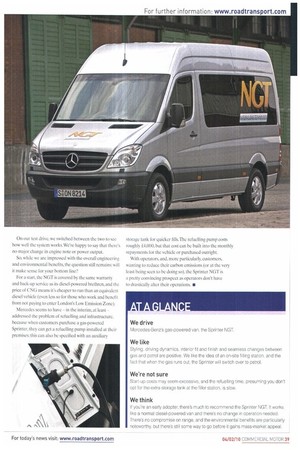It's a gas, gas, gas
Page 38

Page 39

If you've noticed an error in this article please click here to report it so we can fix it.
'Green' gas-powered vans are not a common sight on the UK's roads, but that could change. We get behind the wheel of Mercedes-Benz's Sprinter NGT.
Words: Ian lonkin Mercedes-Benz has developed its own gas-powered van on the Sprinter chassis, called the NGT (Natural Gas 'rechnology).To begin with, the NGT is a standalone model in the Sprinter line-up and it sits alongside the regular diesel-engined variants that you will be more familiar with.
Power comes from a 1.8-litre supercharged fourcylinder petrol engine that produces 156hp and 240Nm of torque, and a claimed gas consumption equivalent to 19.5mpg on the combined cycle.
The Sprinter NGT's nearest rival is Iveco's new EcoDaily van, which has been designed to run on biomethane and also claims the environmental highground with an engine certified to the EEV (Enhanced Environmentally-friendly Vehicle) emissions standard, which itself should exceed the likely requirements for the future Euro-6 legislation.
The gas-powered Mercedes is available on the A The Sprinter NGT is 3.5-tonne and five-tonne Sprinter panel van, dropside available in a variety or box body and, depending on your application, can be of bodyshapes specified with up to six compressed-gas tanks.
This can give you a range of up to 280 miles without having to switch to petrol. However. if you factor in the 75-litre petrol tank, you have a combined range of 700 miles, Mercedes-Benz claims.
For operators with a reason to meet the EEV standard, the Sprinter is available with a 1.4-litre petrol tank and `limp-home' mode required to comply.
So, what's it like to drive? Well, the NGT is just like any other Mercedes-Benz Sprinter in terms of driving dynamics, ride and handling, and interior fitment, although there is one minor difference: next to the ignition is a switch labelled 'NGT' that allows you to change between petrol and gas at any time.
On our test drive, we switched between the two to see how well the system works. We're happy to say that there's no major change in engine note or power output.
So, while we are impressed with the overall engineering and environmental benefits, the question still remains: will it make sense for your bottom line?
For a start, the NGT is covered by the same warranty and back-up service as its diesel-powered brethren, and the price of C:NG means it's cheaper to run than an equivalent diesel vehicle (even less so for those who work and benefit from not paying to enter London's Low Emission Zone).
Mercedes seems to have — in the interim, at least addressed the problem of refuelling and infrastructure. because when customers purchase a gas-powered Sprinter, they can get a refuelling pump installed at their premises: this can also be specified with an auxiliary storage tank for quicker fills.The refuelling pump costs roughly &An but that cost can be built into the monthly repayments for the vehicle or purchased outright.
With operators, and, more particularly. customers, wanting to reduce their carbon emissions (or at the very least being seen to be doing so), the Sprinter NOT is a pretty convincing prospect as operators don't have to drastically alter their operations. •




































































































































